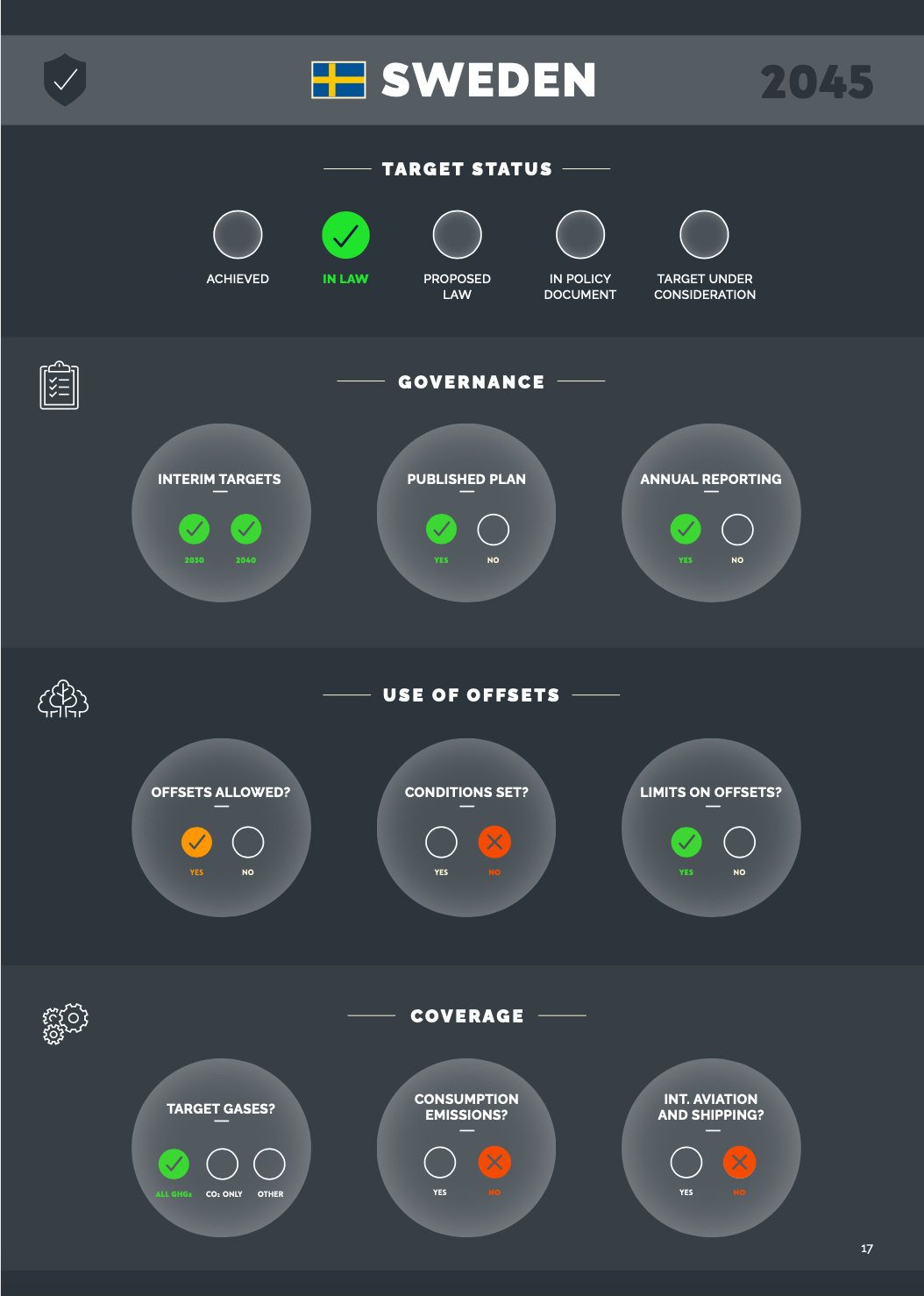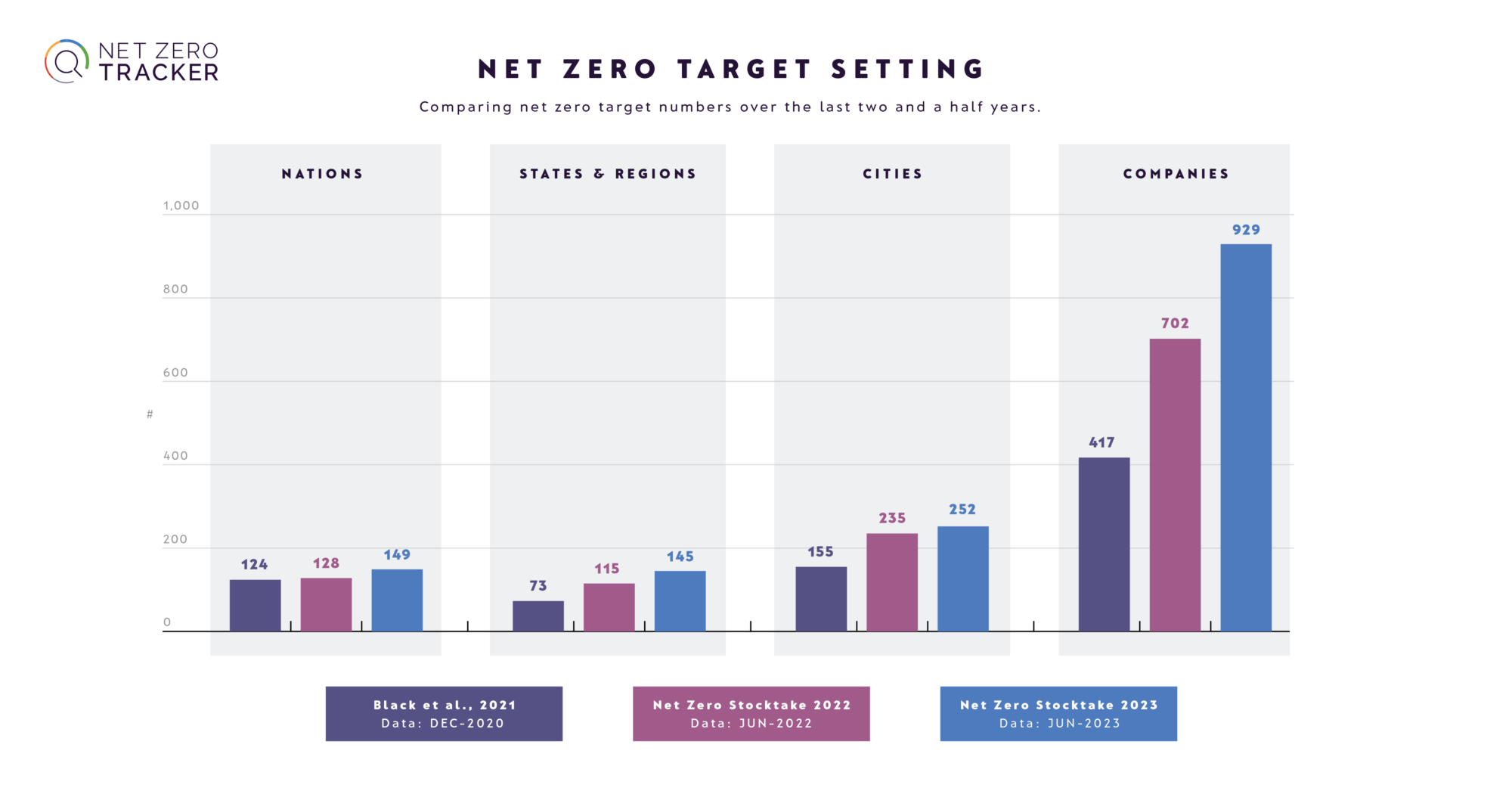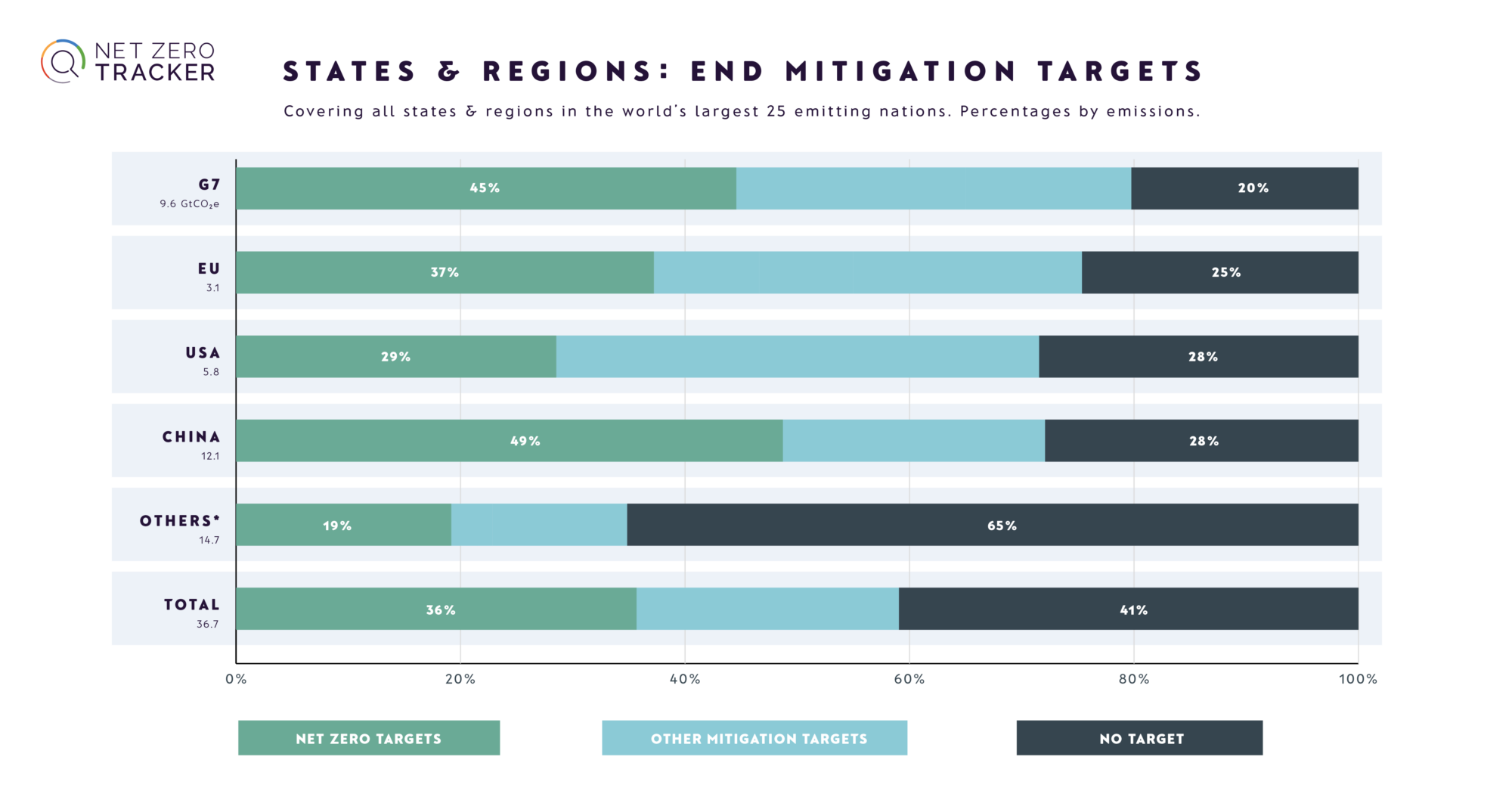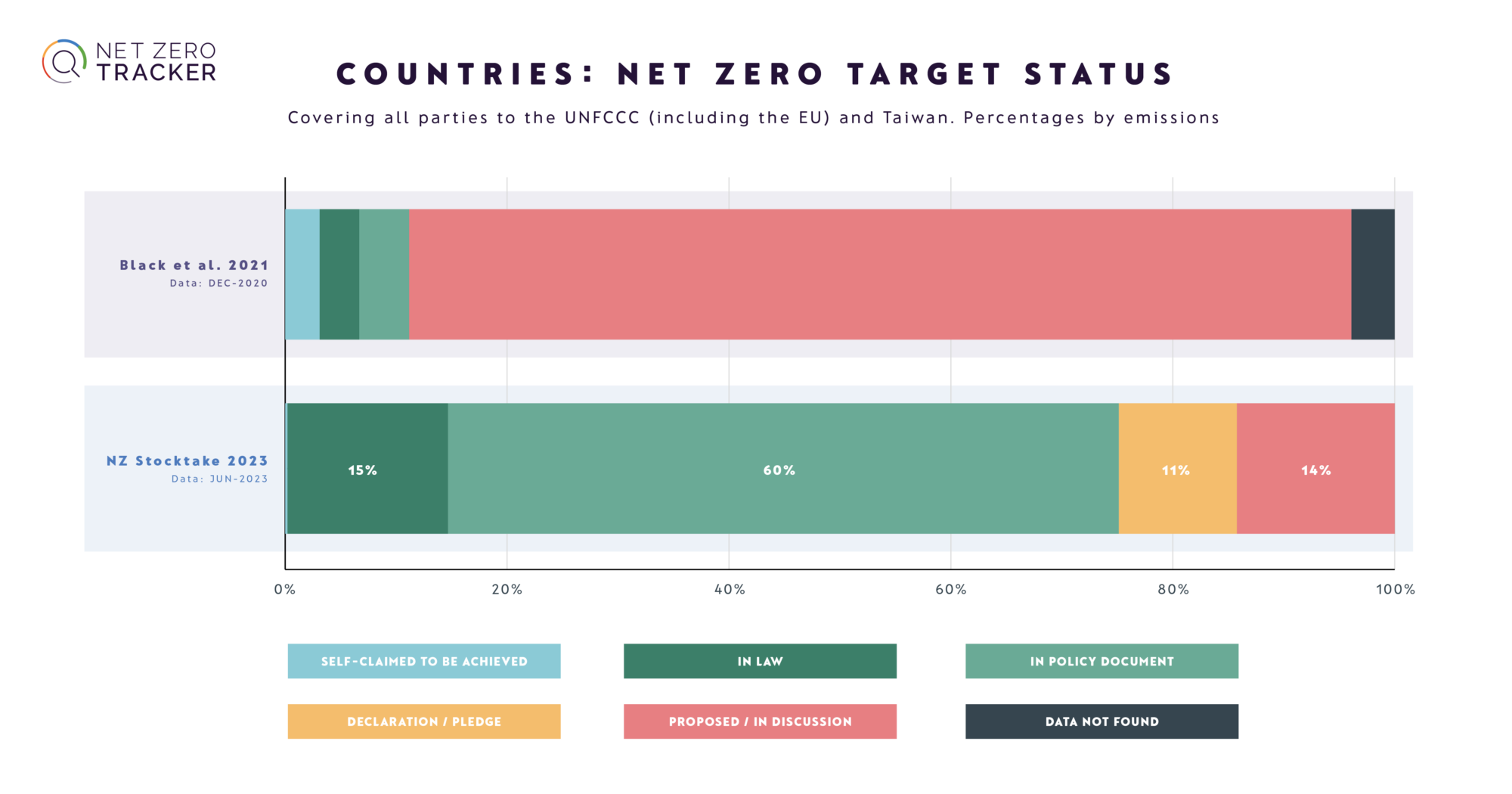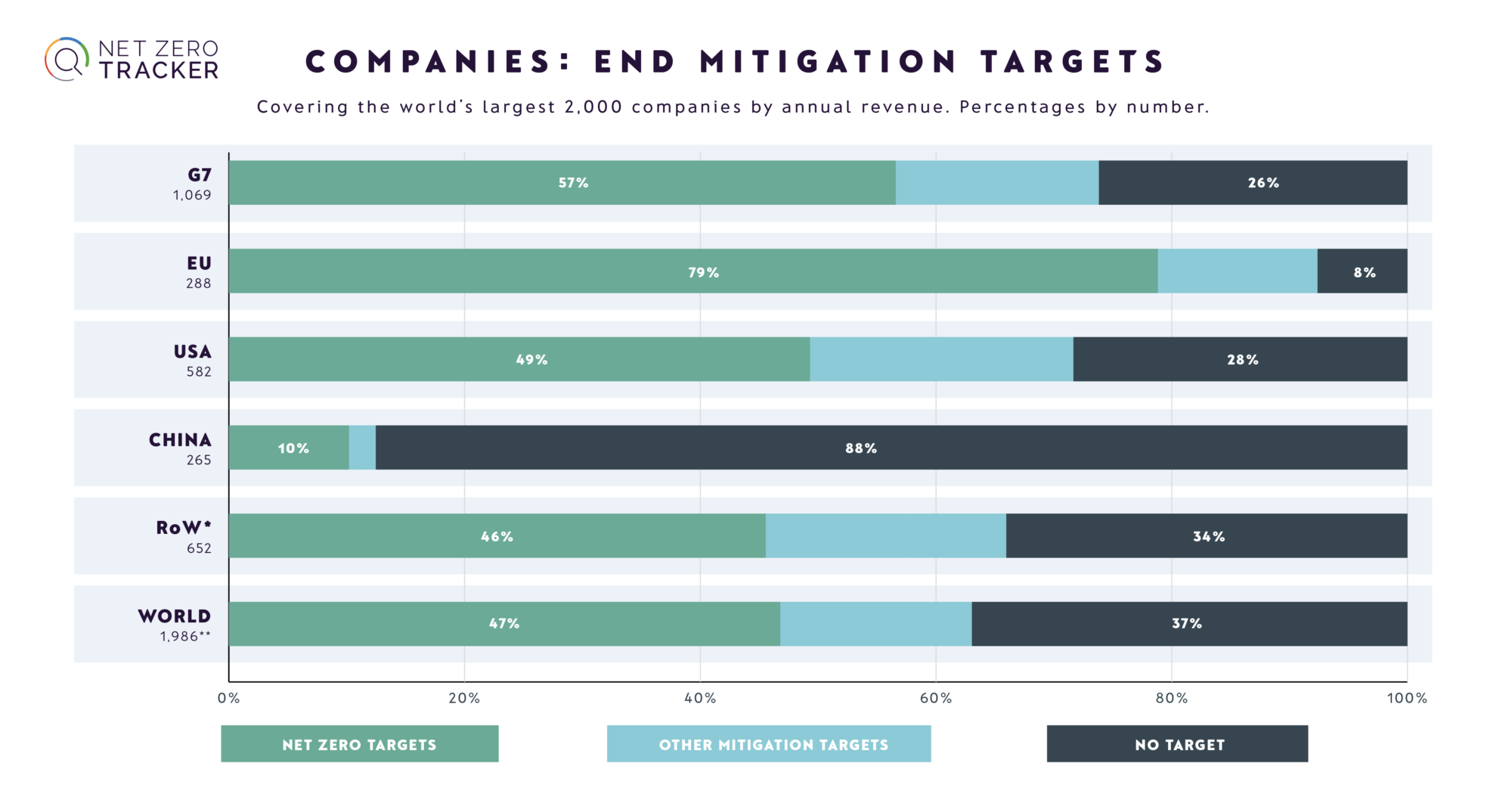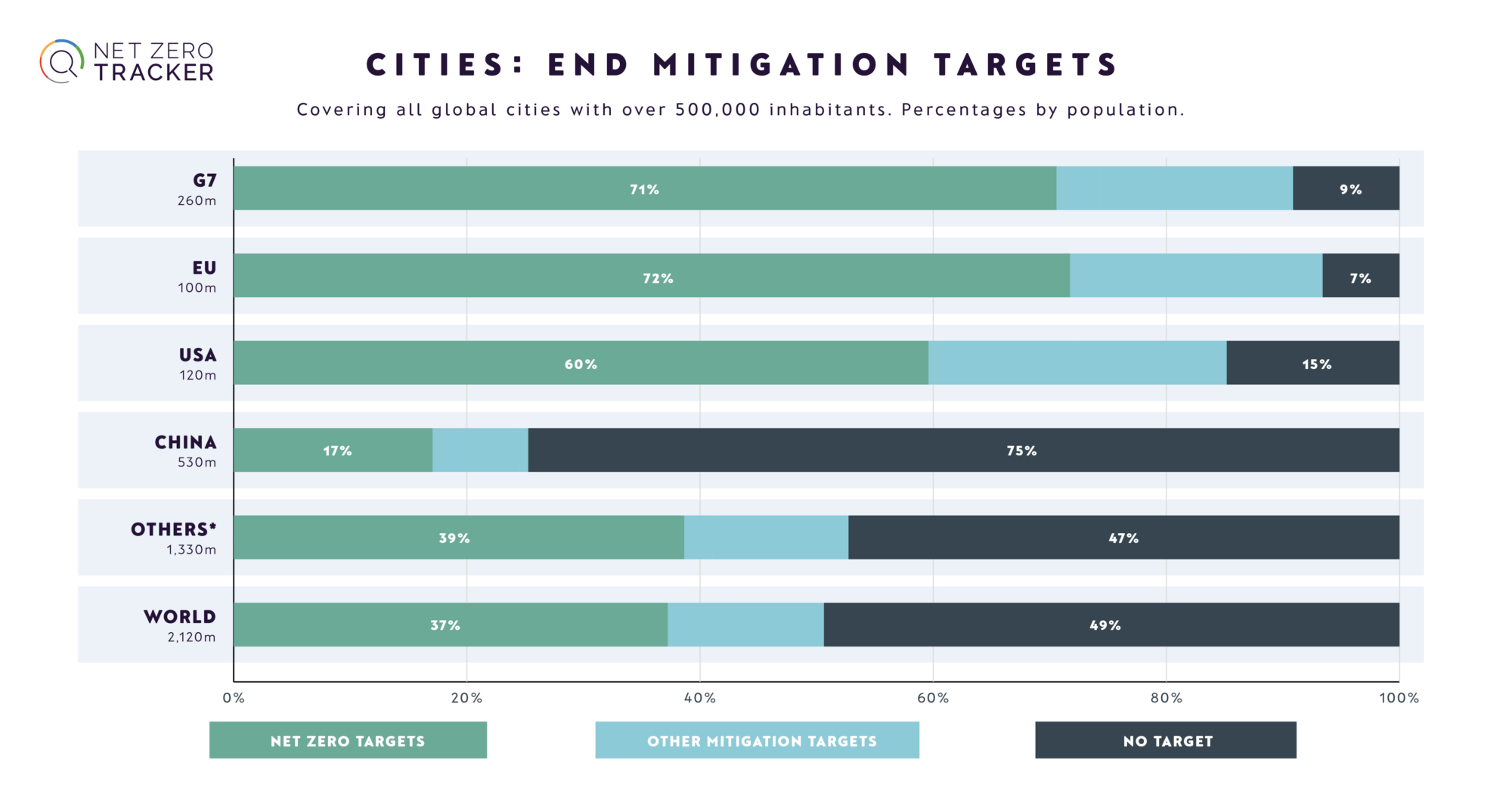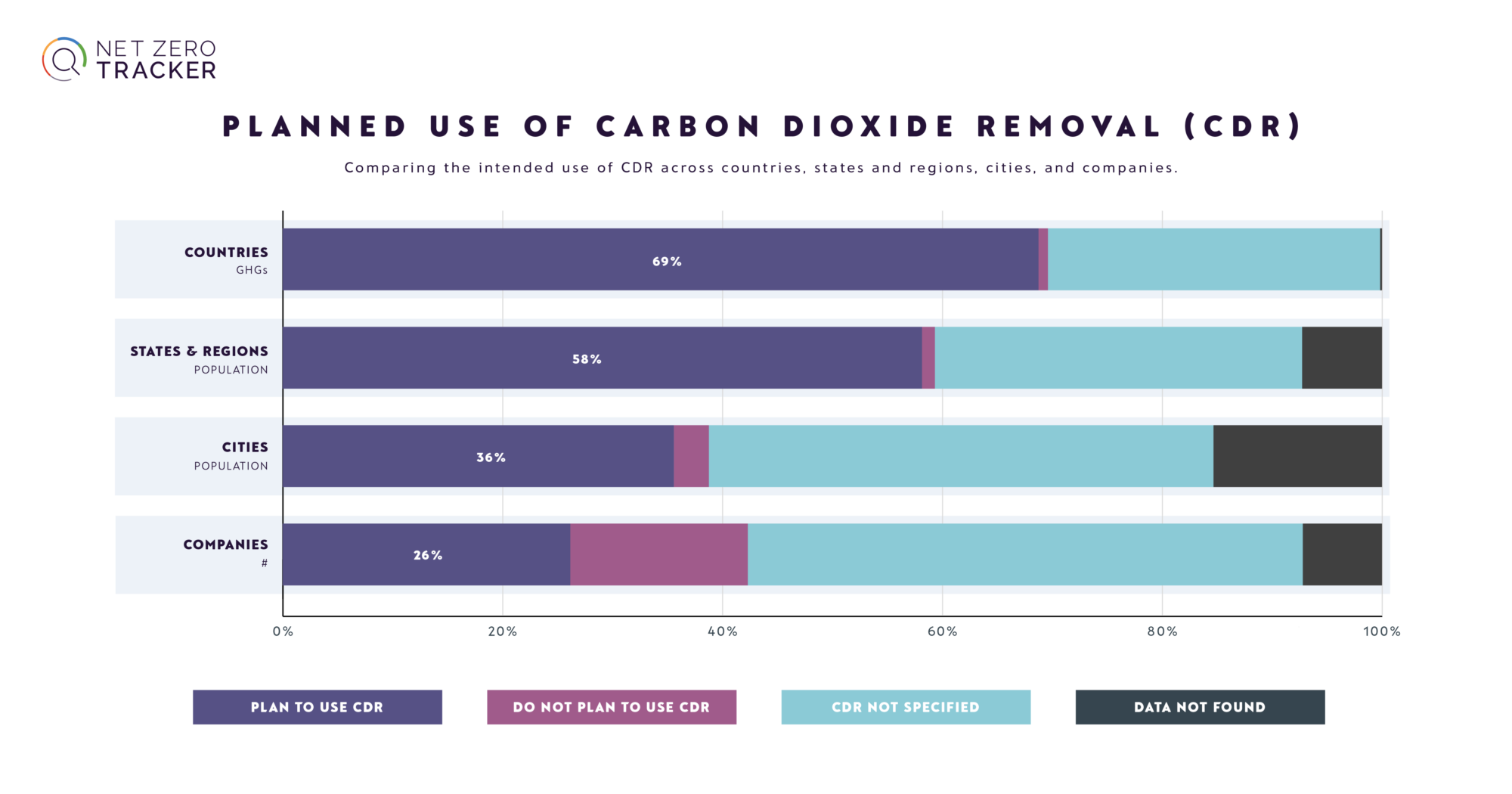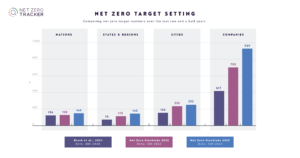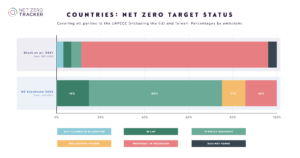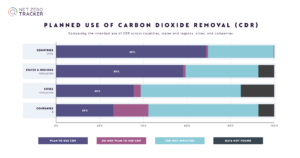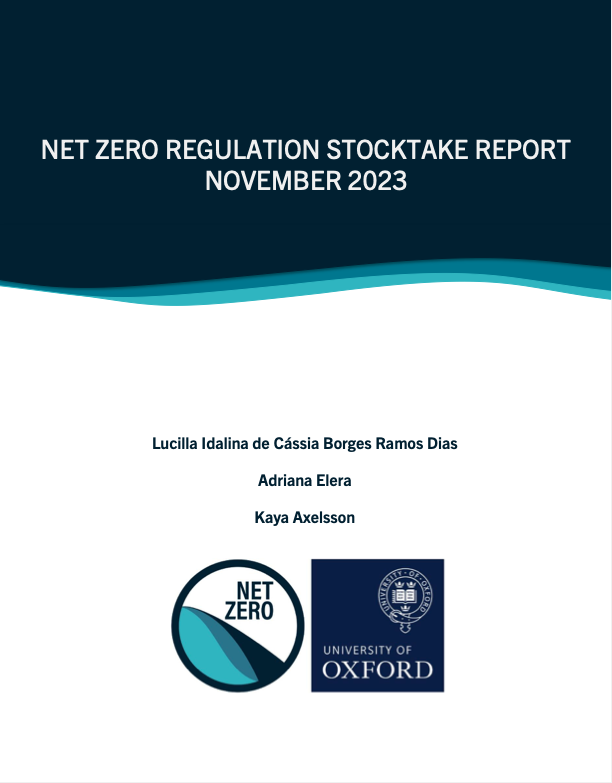Global Net Zero progress
CRITICAL DECADE FOR CLIMATE CHANGE: GLOBAL WARMING IN numbers
The UN’s Intergovernmental Panel on Climate Change (IPCC) reports provide vital and authoritative evidence on climate change to policymakers, governments, and non-state actors. However, the huge time and effort that goes into them means that they are only updated every 5-10 years, which leaves a critical information gap in the intervening years, particularly as the world is rapidly approaching its climate stabilisation targets.
To address this gap, a group of climate scientists from across 17 countries, all closely involved in the latest IPCC report cycle, have formed the new Indicators of Global Climate Change (IGCC) initiative. This group, which includes leadership from researchers from Oxford Net Zero, will provide annual updates to a set of key ‘indicators’ of the climate system, using methods fully consistent with the most recent IPCC assessment cycle, and the latest available information and data.
AVERAGE human-Induced warming in the last decade (2013-2022), relative to pre-industrial
CURRENT LEVEL OF HUMAN-INDUCED WARMING IN 2022 RELATIVE TO PRE-INDUSTRIAL
billion tonnes of CO2 being emitted each year (CO2-equivalent using GWP100)
%
of the world's remaining carbon budget* used up between 2020-2023
Want to see more? A new open data portal, the Indicators of Global Climate Change (IGCC) provides a user–friendly means of tracking and understanding climate change and its progression, in a way that is consistent with the IPCC’s methods.
*The world’s carbon budget is an estimate of how much carbon that can be released into the atmosphere to give a 50% chance of keeping global temperature rise within 1.5°C.
In 2020, the IPCC calculated the remaining carbon budget to be around 500 gigatonnes (billion metric tonnes) of carbon dioxide. By the start of 2023, the figure was roughly half that at around 250 gigatonnes of carbon dioxide.
TRACKING NET ZERO PROGRESS: How aligned are we on the global path to net zero?
“Net zero isn’t only a clear and simple target, it’s what the planet needs in order to halt the rise in temperatures.”
– Dr Steve Smith, Executive Director, Oxford Net Zero
Oxford Net Zero is part of a pioneering team surveying significant entities to track net zero targets globally, aiming to increase transparency and accountability of net zero targets pledged by nations, states and regions, cities and companies.
In June 2023, we published the Net Zero Stocktake 2023 which assesses the status and trends of net zero target setting across countries, sub-national governments and companies.
Report highlights:
-
65% of the annual revenue of the world’s largest 2000 companies is now covered by a net zero target, demonstrating that net zero is becoming a corporate norm.
-
There has been a huge rise in targets enshrined in national legislation or policy in the last 2.5 years, from 10% to 75%. The authors say this shows that net zero has moved from ambition to implementation.
-
Many entities still lack emissions reduction targets. This includes 439 states and regions in the top 25 emitting countries, 766 major cities, and 734 of the largest publicly-listed companies.
-
Integrity is lacking; there are few signs of improvement in national, subnational and company net zero strategies over the past year.
TRACKING GLOBAL NET ZERO COVERAGE
%
Emissions
%
GDP (PPP)
%
Population
Graph: Countries with net zero targets together represent 88% of global emissions, 92% of global Gross Domestic Product (in PPP terms) and 89% of the global population. Source: Net Zero Tracker
EXISTING NET ZERO TARGETS: indicators of quality
%
Meet basic robustness criteria
%
Include interim targets
%
Include a reporting mechanism
%
Include a published plan
Data from the 2021 report: Taking stock: A global assessment of net zero targets https://eciu.net/analysis/reports/2021/taking-stock-assessment-net-zero-targets
Dangers of Greenwashing
Our report highlights that net zero commitments vary hugely in their quality. While 20% of existing net zero targets already meet a certain minimum set of robustness criteria, or ‘starting line’, as set out by the UN Race to Zero Campaign, this leaves significantly more work to be done by governments and business leaders in the months leading up to the UN Climate summit in Glasgow (COP 26).
“While the rapid uptake of net zero targets is encouraging, we need much more clarity from actors on how they plan to get there. It’s particularly important that actors clarify their approach to offsetting.” Dr Thomas Hale, Blavatnik School of Government, University of Oxford
Net zero pledges will only deliver the 1.5°C global warming target if plans are robust and enacted swiftly. Failure to improve commitment to targets with better governance and transparency might leave companies and governments open to greenwashing allegations.
CRITERIA: how NET ZERO commitments are ASSESSED
Timing of targets: What are the key targets and interim years?
- Reach net zero by 2050 ● Set interim targets ● Act immediately
Status: What is the level of progress?
- Achieved ● In Law ● Proposed Law ● In Policy Document ● Under Consideration
Governance: What is the type of monitoring and commitment?
- Formal, top-level commitment ● Interim targets ● Transparency through regular reporting and tracking ● Clear plan with specific operational implications
Use of offsets: What type of offsetting schemes are used?
- Require robust standards (e.g. additionality, permanence, verifiability)
- Specify offsetting approach, avoided emissions, reductions, or removals
Coverage: What type of emissions do targets include?
- All Greenhouse Gases ● Consumption Emissions ● International Aviation and Shipping?
findings (By criteria)
Data from the 2023 report: Assessing the status and trends of net zero target setting across countries, sub-national governments and companies
Focus on Integrity
Until the end of 2022, entities with a net zero target could assert the credibility of their plans despite lacking specific elements. This was due to a lack of universally recognised credibility requirements. A new report titled ‘Integrity Matters: Net Zero Commitments by Businesses, Financial Institutions, Cities and Regions’ was published at the 2022 UN climate summit, COP27, setting out 10 recommendations for a net zero target. These include having regular interim targets (beginning in 2025), not using offset credits, committing to end fossil fuel usage, and outlining a socially and ecologically fair transition to net zero.
These recommendations will frame future UN discussions over net zero, acting as universal markers all net zero targets can be compared against. Thus, no company, city or region can claim to not know what a credible target is. The remit of this report did not include national governments, but the recommendations logically apply still.
UNFCCC Integrity Matters: Net Zero Commitments by Businesses, Financial Institutions, Cities and Regions’ Report: https://www.un.org/sites/un2.un.org/files/high-level_expert_group_n7b.pdf
Net Zero target Setting
Click here to enlarge the graph.
-
- Largest growth (123%) in net zero target setting by companies from 2021-2023

- From 417 to 929 publicly listed companies
- Rate of growth for nations, states & regions, and cities has slowed
- But net zero targets for nations now represent 88% of global GHG (greenhouse gas) emissions
- Targets for states & regions now cover a population of 1,457 million, compared with 497 million in December 2020
- Targets for cities now cover a total population of 787 million, compared with 640 million in December 2020
- 1,475 entities now have a net zero target out of 4,000 entities tracked, up from 769 in December 2022.
- Largest growth (123%) in net zero target setting by companies from 2021-2023
Status of Net zero targets: Countries
Click here to enlarge the graph.
- Substantial increase in net zero targets underpinned by legislation and policy documents.

-
-
- Now 15% net zero targets are enshrined in law, compared to <5% in 2020.
- 60% of net zero targets are in policy documents, compared to <10% in 2020.
-
- Represents 75% of all GHG emissions covered by national net zero targets.
Status of Emission Reduction Targets: Non-state entities
Click here to enlarge the graphs.
- Significant share of subnational and corporate entities lack an emissions reduction target.
- 1/3 of GHG emissions are covered by subnational state & regional level net zero targets from the included 25 countries.
- Substantial lack of subnational emission reduction targets for regions that account for more than 40% of national emissions, despite national net zero plans in place
- 41% of states & regions have no emission reduction target.
- 49% of cities globally have no emission reduction target.
- 37% of companies globally have no emission reduction target.
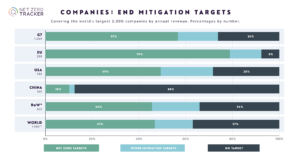
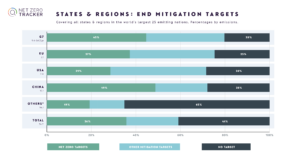
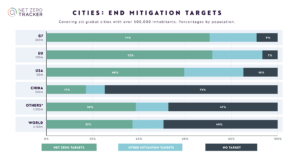
Integrity in subnational and corporate net zero targets
- Limited signs of improvement in subnational and corporate net zero integrity
- Very few subnational and corporate entities meet UNFCCC Race to Zero Criteria:
- This includes setting a specific net zero pledge, including all GHGs, publishing a plan, publishing annual progress, and clarifying offset conditions
- 3% of states & regions
- 3% of cities
- 4% of companies
- Key concerns of integrity center on the inclusion of scope 3 emissions and unregulated use of offsets
- 13% of corporate net zero targets qualify offset conditions.
- 37% of corporate net zero targets cover scope 3 emissions.
- Scope 3 refers to a company’s emissions from across its value chain.
Use of Carbon Dioxide Removal (CDR)
Click here to enlarge the graph.
- More entities have clarified their intention to use carbon dioxide removals within their value chain.

- 69% of countries plan to use carbon dioxide removals (CDR)
- 58% of states & nations plan to use CDR.
- 36% of cities plan to use CDR.
- 26% of companies plan to use CDR.
- There are concerns about an overdependence of CDR by non-state actors to reach their net zero targets from the international community.
Fossil Fuels
- Despite having net zero pledges, no major producer countries or companies have committed to phasing out fossil fuels.
- 67% increase in fossil fuel companies pledging net zero targets
- From 51 in June 2022 to 75 in June 2023
- But no fossil fuel companies are making the necessary commitments to transition away from fossil fuel extraction or production.
NET ZERO REGULATION STOCKTAKE: WHAT PROGRESS IS THE WORLD MAKING ON REGULATING FOR A NET ZERO FUTURE?
A new report discusses the 2023 Stocktake conducted by Oxford Net Zero, focusing on global regulations related to the transition to net-zero emissions.
Between May and August 2023, the stocktake assessed climate regulations and policy instruments from G20 members, categorizing them into domains such as claims and financial product standards, disclosure, procurement, and transition plans.
The findings reveal that a majority of G20 nations have implemented regulations in at least one domain, highlighting the global effort toward decarbonization, and voluntary standards are transitioning into mandatory national regulations.
findings (By criteria)
Data from the 2023 report: Assessing the status and trends of net zero target setting across countries, sub-national governments and companies
Focus on Integrity
Until the end of 2022, entities with a net zero target could assert the credibility of their plans despite lacking specific elements. This was due to a lack of universally recognised credibility requirements. A new report titled ‘Integrity Matters: Net Zero Commitments by Businesses, Financial Institutions, Cities and Regions’ was published at the 2022 UN climate summit, COP27, setting out 10 recommendations for a net zero target. These include having regular interim targets (beginning in 2025), not using offset credits, committing to end fossil fuel usage, and outlining a socially and ecologically fair transition to net zero.
These recommendations will frame future UN discussions over net zero, acting as universal markers all net zero targets can be compared against. Thus, no company, city or region can claim to not know what a credible target is. The remit of this report did not include national governments, but the recommendations logically apply still.
UNFCCC Integrity Matters: Net Zero Commitments by Businesses, Financial Institutions, Cities and Regions’ Report: https://www.un.org/sites/un2.un.org/files/high-level_expert_group_n7b.pdf
Net Zero target Setting
Click here to enlarge the graph.
-
- Largest growth (123%) in net zero target setting by companies from 2021-2023

- From 417 to 929 publicly listed companies
- Rate of growth for nations, states & regions, and cities has slowed
- But net zero targets for nations now represent 88% of global GHG (greenhouse gas) emissions
- Targets for states & regions now cover a population of 1,457 million, compared with 497 million in December 2020
- Targets for cities now cover a total population of 787 million, compared with 640 million in December 2020
- 1,475 entities now have a net zero target out of 4,000 entities tracked, up from 769 in December 2022.
- Largest growth (123%) in net zero target setting by companies from 2021-2023
Status of Net zero targets: Countries
Click here to enlarge the graph.
- Substantial increase in net zero targets underpinned by legislation and policy documents.

-
-
- Now 15% net zero targets are enshrined in law, compared to <5% in 2020.
- 60% of net zero targets are in policy documents, compared to <10% in 2020.
-
- Represents 75% of all GHG emissions covered by national net zero targets.
Status of Emission Reduction Targets: Non-state entities
Click here to enlarge the graphs.
- Significant share of subnational and corporate entities lack an emissions reduction target.
- 1/3 of GHG emissions are covered by subnational state & regional level net zero targets from the included 25 countries.
- Substantial lack of subnational emission reduction targets for regions that account for more than 40% of national emissions, despite national net zero plans in place
- 41% of states & regions have no emission reduction target.
- 49% of cities globally have no emission reduction target.
- 37% of companies globally have no emission reduction target.



Integrity in subnational and corporate net zero targets
- Limited signs of improvement in subnational and corporate net zero integrity
- Very few subnational and corporate entities meet UNFCCC Race to Zero Criteria:
- This includes setting a specific net zero pledge, including all GHGs, publishing a plan, publishing annual progress, and clarifying offset conditions
- 3% of states & regions
- 3% of cities
- 4% of companies
- Key concerns of integrity center on the inclusion of scope 3 emissions and unregulated use of offsets
- 13% of corporate net zero targets qualify offset conditions.
- 37% of corporate net zero targets cover scope 3 emissions.
- Scope 3 refers to a company’s emissions from across its value chain.
Use of Carbon Dioxide Removal (CDR)
Click here to enlarge the graph.
- More entities have clarified their intention to use carbon dioxide removals within their value chain.

- 69% of countries plan to use carbon dioxide removals (CDR)
- 58% of states & nations plan to use CDR.
- 36% of cities plan to use CDR.
- 26% of companies plan to use CDR.
- There are concerns about an overdependence of CDR by non-state actors to reach their net zero targets from the international community.
Fossil Fuels
- Despite having net zero pledges, no major producer countries or companies have committed to phasing out fossil fuels.
- 67% increase in fossil fuel companies pledging net zero targets
- From 51 in June 2022 to 75 in June 2023
- But no fossil fuel companies are making the necessary commitments to transition away from fossil fuel extraction or production.
